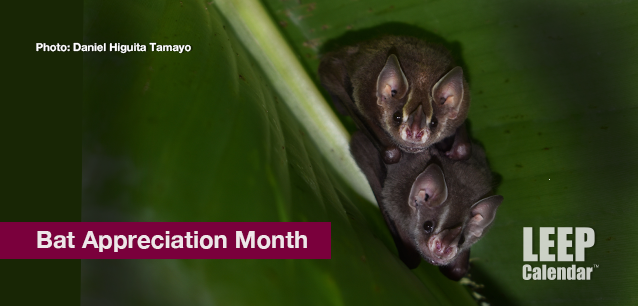 AD
AD
Today is: December 07
Scroll to explore events active on this date.
Additional Events on LEEP
LEEP INK FEATURES

August? Absolutely!
In August, we live through the Dog Days of Summer. It's hot and often humid, and those who can leave for better climates do. Down south, winter is in full force. August is also known as "the ...

In The Heat of July: July 2025 Events
Is it hot enough (or cold enough if you're below the equator) for you yet? There is actually a day for that! Like every month, I pick a diverse collection of events you may or may not know about. This ...

May Blooms: Events in May 2025
Along with October, May is one of the most densely packed months of the year. It's before the summer humidity and the last whole month of the school year. The weather is warming in t...
About Bat Appreciation Month
Ends: Oct 31, 2024
DESCRIPTION:
Bat Appreciation Month celebrates and creates awareness about the incredible creatures that rule the night skies. Bats are mammals of the order Chiroptera and include over 1,400 species, representing about 20% of all classified mammal species worldwide. As such, bats are the second largest order of mammals after rodents and live in every part of the planet except for extreme desert and polar environments.
Sizes of bats vary, ranging from the smallest with a wingspan of 15 cm to 170 cm for the largest bat species, the giant golden-crowned flying fox. They also exhibit a wide range of diets: most bat species feed on insects, but others eat fruit, nectar, small mammals, fish, and even blood, like the three species of vampire bats.
Bats play vital roles in many ecosystems around the world:
Pollination and Seed Dispersal: Bats are pollinators for many tropical and subtropical plants. They eat fruit and nectar, then disperse seeds, contributing to the growth of plants and trees, forming habitats for other wildlife.
Insect Control: A single bat can eat hundreds to thousands of insects a night, depending on the species and size of the bat. They are essential in controlling insect populations and reducing the need for pesticides.
Indicator Species: Because they are sensitive to environmental changes, bats are often considered indicator species. A decline or shift in bat populations can highlight habitat destruction or climate change issues.
Nutrient Distribution: Bats also help distribute nutrients across environments. For example, when bats in caves defecate, their droppings (guano) are rich in nutrients, which can benefit cave-dwelling organisms and are harvested by humans as a valuable fertilizer.
However, bats are threatened globally by habitat loss, hunting, invasive species, and diseases such as the White-nose Syndrome in North America and Europe. Also, they've been implicated in the spillover of zoonotic diseases to humans, such as the coronavirus. Despite these challenges, they are essential to our planet's health and biodiversity.
VIDEOS
SUPPORTING DOCUMENTS
Currently, this event does not have supporting documents.
ADDITIONAL IMAGES
Currently, this event does not have supporting images.
Where would you like to go now?
 AD
AD


/footer-logo.svg)
